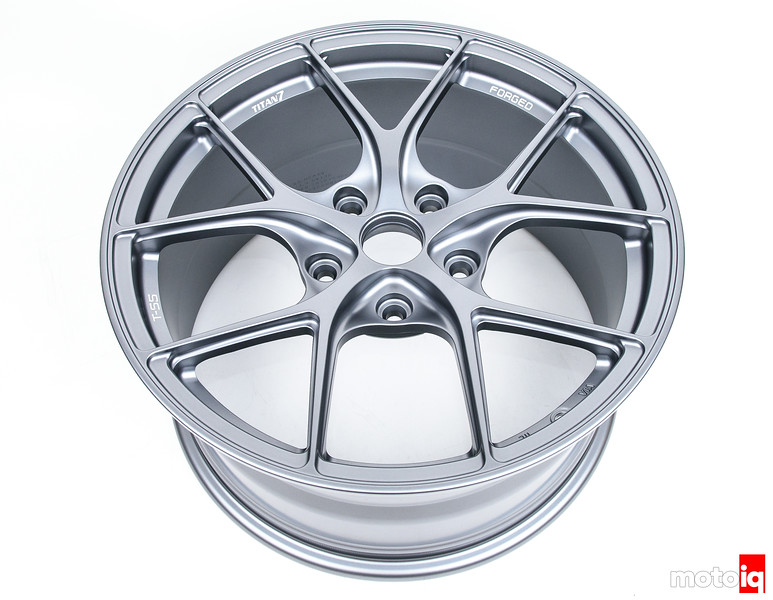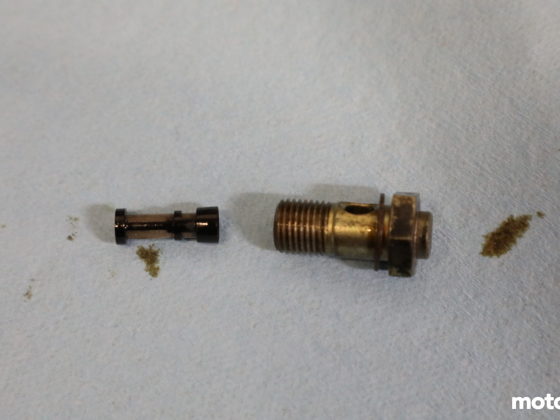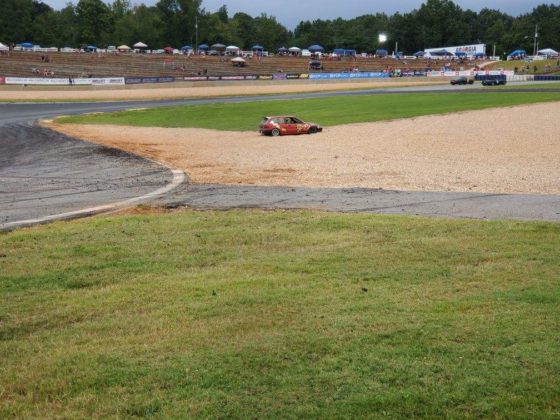
In the front, after the car was lowered the anti-dive geometry became pro-dive because in stock form the 987 has very little anti-dive geometry. We fixed this to be more neutral by raising the front pivot point of the tension rods using the Tarett adjusting spacers.

Now it was time to finish off our suspension installation with precision alignment. We went to West End Alignment as their business is motorsports level chassis set up. It is also great that they are about a mile from our shop. Chris Nishimura starts our alignment by spraying a white stripe on our tires.

Next, he scribes a thin white line down the middle of each stripe.

The thin line will be used to measure toe very accurately.

Next Chris measures the rear camber starting in the rear.

The Tarett arms can be adjusted for camber using shims but we used the length adjustment to push the car’s wheels outward to make the rear track as wide as possible. A wide track increases the amount of grip at that end by reducing the weight transfer to the outward tires and using the inside tires more. It also looks good. Lengthening the arim is a better way to do this than using spacers if you have the ability to do so. Longer arms have less side scrub and in the case of a strut car, better camber gain. With the gross camber and track width set with the shims, we did the fine adjustment using the factory eccentrics. Following the advice of some successful Cup Car racers using the same tires, we set the camber and 3 degrees negative.




10 comments
Great as usual, curious to see how this does on the track. I run the atx-20 on my wrx. At three pounds and change it’s great. My car starts better with this over the factory battery, however it sits on a battery tender. While I haven’t had to use the restart feature, it’s another reason to like this battery.
Have you thought about this?
https://www.autoquestcars.com/custom-09
I would be careful and run a battery tender that is for lithum batteries only! A well-known friend of ours blew up his car and almost burned down his shop because he used the wrong trickle charger!
My opinion of this kit is that the upper links are way too short and you will have too much camber gain for rear-driven wheels. The short links can also contribute to jacking and lots of roll center and instant center migration. The short links will also cause side scrub which can contribute to instability on split mu surfaces and under certain load conditions. Lastly, the anti-squat percentage is really high and that can contribute to a loss of traction under corner exit as well as wheel hop. The Cayman/Boxter chassis has wheel hop as a known issue and they exhibit a high degree of anti.
I may be working with a well-known Porsche suspension parts company next year to develop my own solution to these issues on the 987 chassis which if it comes to fruition will be much better than this! At least in my own opinion.
Oh yeah, I use a lipo specific one. Not making that mistake. Lipo fires are for Richard Hammond anyways.
Competition is a wonderful thing, love to see what is born!
Got to run the car pretty hard today after some shock tuning. The owner reports that it’s pretty awesome.
Great articles. Looking forward for the next updates!
I enjoyed the 3 pages on the alignment and all of the other 987.2 Cayman content. Can you write more about setting the anti squat / dive front and rear? Also, about how the team measured the bump steer? All of the specs? Have you run the car on track yet? How did it feel, any adjustments?
I have a 987.2 will all of the Tarett parts that your car has and have not been able to find a shop around Atlanta that will got to this level of detail.
Thank you
We are waiting for softer front springs right now. I want to go down to 10 kg and KW is backordered. The balance of the car is ok but there is a minor pitch issue I think is frequency related so I want to go softer spring wise in the front and up in the front bar. As far as bump steer, Porsche is pretty well designed and there isn’t much, but if you mess with the roll center you need to move the tie rods by close to the same about or you will get bumpsteer. Basically, if you want to measure it you take off the springs and move the car up and down and measure toe every inch and plot it. However, we did this and the toe curve on these cars is pretty good. I would talk to my local PCA or POC racers and they probably know a prep shop that can properly align and corner balance your car. The specs we gave in the article were pretty aggressive like what cup cars run so they would kill your tire on the street if your car is a daily. To make it simple to reduce anti we shimmed the front trailing arm pivot down, The 987 has a lot in the rear.
Great looking build! I have a 987.2 I am setting up similarly for HPDE days.
Any chance you can provide some insight into your recommended ride height and how you came up with it?
I’ve got Ohlins on mine, and I have lowered it too far. My LCAs are pointed upward on the outside and thus my roll center is super low and my camber curve isn’t great. I’m trying to figure out how high to raise it but I’m a little lost.
Thanks!
We lowered the outer LCA pivot by putting a spacer on the spherical bearing. We also lowered the tie rod to reduce bump steer.
Okay cool. I have that ability with my front LCAs but I am still stock in the rear. Did you aim to have your LCAs at a certain angle at ride height or at full compression?